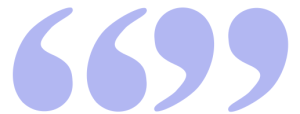Integrating Source Material with Your Ideas
 When style guides want you to list sources at the end, they only want you to list the sources that you have actually cited in your work. It is not enough to have the required number of sources in the list of references at the end of your project. Instead, you must actually use those sources in the text. This means that the sources cannot simply be decoration.
When style guides want you to list sources at the end, they only want you to list the sources that you have actually cited in your work. It is not enough to have the required number of sources in the list of references at the end of your project. Instead, you must actually use those sources in the text. This means that the sources cannot simply be decoration.
You can use the instructions for checking citations as a technical way to check that you have referenced all of your sources; however, more is involved in using sources well.
Quoting and Paraphrasing Successfully
Every time you use information from another source, you have to cite that material. But what else do you have to include? It depends on how many sources you are bringing together, but in general, you will need to have these elements:
- Some attribution for the source, usually in the form of an attribute tag and/or a citation
- The quotation itself (only if you are quoting; you don’t need this if you are just paraphrasing)
- A paraphrase of the text you are using
- A connection to your claim in the paragraph or in the paper as a whole
Attributive Tags and Citations
An attributive tag is usually a quick phrase that indicates who said the words you are quoting or where the information comes from. For example, you could begin your introduction of the source material with “Jones argues …,” or “According to the National Institutes of Health ….” This approach works best when you are using a single source.
However, sometimes, you don’t want to highlight the source, or you are following a style guide that only wants references to sources in citations. Citations can serve the same purpose in many circumstances, and they work particularly well when you are paraphrasing multiple sources.
Quotations and Paraphrases
 If you are quoting, you need the quotation, obviously. Less obvious, however, is that you usually need a paraphrase even when you are quoting from a source—simply because your reader needs to understand how you understand the quotation you’ve selected. Sometimes, the quotation is so plain that a paraphrase is simply redundant, but more often, you need the paraphrase to point out what you think is important about the quotation.
If you are quoting, you need the quotation, obviously. Less obvious, however, is that you usually need a paraphrase even when you are quoting from a source—simply because your reader needs to understand how you understand the quotation you’ve selected. Sometimes, the quotation is so plain that a paraphrase is simply redundant, but more often, you need the paraphrase to point out what you think is important about the quotation.
It may seem easier to quote complete sentences, even if you need to write additional sentences of paraphrase. However, one way to increase the level of sophistication in your writing is to quote the bare minimum of what you need from the passage you have selected and to use a paraphrase to explain the idea behind the full passage. This mixture of paraphrase and quotation demonstrates very well your understanding of the material, and it shows your reader that you are working actively to explain what the original says.
View the example.
Let’s look at an example of the kind of difference in sophistication level that I am talking about. Nikk Ogasa reported on “ghost games” in soccer and the effects on referees for the site ScienceNews. Here’s a paragraph from that story:
“Referees indeed give advantage to the home teams, because of the crowds,” Leitner [a sports psychologist who is one of the researchers on this study] says. But the findings suggest that referee bias tends to disappear when fans do. While it’s natural for people to change their opinions under pressure from others, Leitner says, hopefully this work can help referees become more aware of their biases. “When you know it, you can train against it.”
The ideas in this paragraph are central to the point that referees have bias when fans are present. I could choose to quote full sentences from this paragraph:
Ogasa reports that “’Referees indeed give advantage to the home teams, because of the crowds,’ Leitner [a sports psychologist who is one of the researchers on this study] says. But the findings suggest that referee bias tends to disappear when fans do.”
However, if I choose just the words I really want to quote and blend in paraphrase, my explanation will be clearer and my own writing will be stronger:
According to research by sports psychologists at the University of Salzburg in Austria, referees are affected by the presences of fans. They found that referees favor home teams when crowds are present, but “that referee bias tends to disappear when the fans do” (Ogasa).
Most of my paragraph is paraphrase, but I have kept a little quotation, selected specifically because it is phrased so well (remember the reasons for quoting!). The result is a much more sophisticated version of the material.
Making Connections Between the Source and Your Ideas
 Finally, your reader needs you to make a connection between the source you have quoted and/or paraphrased and the claim you are making. In other words, it is not enough to drop a quotation in and expect your reader to understand, even if you properly paraphrase and cite it. Your reader also needs to know how you think this source is connected to your point.
Finally, your reader needs you to make a connection between the source you have quoted and/or paraphrased and the claim you are making. In other words, it is not enough to drop a quotation in and expect your reader to understand, even if you properly paraphrase and cite it. Your reader also needs to know how you think this source is connected to your point.
Students sometimes tell me that they don’t include this because they think the quotation speaks for itself. But in academic writing, you cannot make that assumption. Your readers need that explanation, even if the connection seems obvious to you. Remember that readers (including your professor!) want to hear you, not just your sources, so make your ideas clear. You can also use this as an opportunity for paragraph development, which will help you meet your word count.
There are no rules about where this explanation appears. Sometimes it appears after you have presented the source material, but it can also appear before—or both. The connections you make can also appear in your topic sentence.
Differing Numbers of Sources
What you need to include changes a bit depending on how many sources are involved.
Using a Single Source
 If you are focusing attention on one source in a paragraph, you need to have all of the elements listed above. Your reader needs to know why you have focused attention on this particular source, so your explanations may be more specific or involved. Don’t be afraid to give your reader a little extra information about the source itself or the background behind the material you are using. And definitely make a clear connection between that source and your point in the paragraph.
If you are focusing attention on one source in a paragraph, you need to have all of the elements listed above. Your reader needs to know why you have focused attention on this particular source, so your explanations may be more specific or involved. Don’t be afraid to give your reader a little extra information about the source itself or the background behind the material you are using. And definitely make a clear connection between that source and your point in the paragraph.
Using Multiple Sources
 If you are focusing an idea and using multiple sources in the same paragraph, what you need to include changes a bit, though the parts are all still present:
If you are focusing an idea and using multiple sources in the same paragraph, what you need to include changes a bit, though the parts are all still present:
- Attribution, which usually comes in the form of citation for all sources when there are multiple sources
- Information from the sources, usually in the form of paraphrase, but quotations can also be appropriate, if used sparingly
- Explanatory sentences that connect the source material to your claim in the paper
When you are using multiple sources in the same paragraph, it can be easy to get caught up in using those sources, and forget the explanation. Don’t! Your reader needs that explanation.
Sometimes, though, you may need to use a couple of paragraphs to fully present the ideas from multiple sources and the explanation to go with it. There is nothing wrong with that. Remember that some topics take more than one paragraph to explain.
Key Points: Integrating Source Material with Your Ideas
- Each time you use source material in your writing, you need the following
- A reference to the source in a citation or attributive tag
- A quotation (if you are quoting)
- A paraphrase, even if you are quoting, unless the meaning of the quotation would be completely obvious to your reader
- An explanation that connects the idea of your source to the point in your paragraph or in your paper as a whole.
- Your quotation use can be more sophisticated if you minimize the number of words you quote and incorporate them into paraphrases.
- When you are using only one source, you can provide your reader with additional information about that source, assuming the style you are using allows for that.
- When you are using multiple sources in a paragraph, you will rarely quote, and your citations will often contain references to multiple entries in your references list.
Media Attribution
“Stacked Books” by rawpixel is in the Public Domain, CC0
“Quotation Marks” by Philroc, Wikimedia Commons is in the Public Domain, CC0
“Networking” by PxHere is in the Public Domain, CC0
“Red Clipart Book” by rawpixel is in the Public Domain, CC0
“Many Books” by rawpixel is in the Public Domain, CC0
You know the definition of plagiarism—using someone else’s words, work, or ideas and passing them off as your own. Some plagiarism is intentional. Using an essay-writing service, for example, is obviously and intentionally plagiarism. So is using AI to write your paper when your instructor has told you not to. These acts are wrong, and we all know it, so I don’t have much to say about them here.
However, the majority of plagiarism—at least in first-year college classes—is inadvertent. It usually happens when a student is trying to paraphrase, quote, or cite a source, but they fail to do so correctly. Let’s take each of these in turn.
Paraphrasing and Plagiarizing
Paraphrase is the biggest culprit. When a student tries to paraphrase, but ends up patchwriting instead, the language sticks too close to the original. The best way to avoid this, at least until you become more expert with paraphrasing, is the process I describe in the section on paraphrasing:
- Understand the passage
- Close the source
- Give yourself a short break
- Write the paraphrase
- Check it against the original
If your paraphrase is still too close to the original in either word choice or sentence structure (or both), try paraphrasing your paraphrase.
Quoting and Plagiarizing
Quotations make it easier to avoid plagiarism, but you can still make mistakes.
The most common mistake I see is a student’s failing to use quotation marks when the words come directly from the source. When you use exact language from a source, even if it is a phrase of just a few words, you must use quotation marks. You don’t need to do this around commonly used language and phrasing, but if the wording is at all specific to the source, you need to include the quotation marks. If you don’t have quotation marks around that exact language, you are claiming the language as your own, which could be considered plagiarism.
Citing and Plagiarizing
Sometimes students forget to include the citations themselves, which can be considered plagiarism. Every time you quote and every time you paraphrase, you need to give credit to your source. The specifics of what the citation will look like vary, but if you don’t have a citation, you could be accused of plagiarism.
This is especially true of in-text citations. Most professors will see a source missing from your list and assume a mistake, but missing in-text citations, particularly when citing paraphrases, aren’t as obviously mistakes.
This problem seems to happen most to students who think that they will add the citations later. While this strategy can work to help you keep drafting, if you don’t leave yourself some kind of reminder that you need to add the citations, you can have a serious problem later on. If you draft this way, I recommend that you add parentheses as a reminder. It can be even more helpful if you put some kind of reminder about which source you are using.
Another common problem I see is students thinking that it’s enough to include a citation at the end of a paragraph, particularly when there are several sentences from the same source that require citation. I’ve also seen this at the end of slide decks, where students skip the in-text citations.
This is not sufficient! While there are more elegant and sophisticated ways to cite, you are better off adding a parenthetical citation to the end of every sentence than to leave one off. Look at it this way: If you cite too much, at worst, your professor will tell you that you don’t need so much citation. If you cite too little, you can be accused of plagiarism.
If you have a long-ish section of material coming from the same source, such as when you are writing a summary, your best bet is to open that section with a reference to the author (in the sentence itself if your style guide and/or professor allows this), and then reminding your reader that the ideas are coming from that author another one or two times during the section by using pronouns and attributive tags to signal that these ideas are not yours. And remember that you must include page numbers whenever your quote or paraphrase (again, unless directed otherwise by your style guide and/or professor).
Plagiarizing Sources Other Than Writing
Written words are not the only things that can be plagiarized. If you include images, videos, sound clips, or other media that you did not create yourself, you need to give credit to the creator of those texts. Usually, this is done in a caption, particularly if the final product is a paper. Different style guides will have instructions for citing in captions, but if you aren’t sure how best to do this, ask your professor.
To understand plagiarism, it helps to understand a bit about the idea of intellectual property
Copyrighted work is owned by that work’s creator until and unless they assign their rights to someone else or until they apply a license. The technicalities are not terribly important for our purposes, but as a student, you should assume that all written text, audio files, images, and video you have access to is copyrighted, whether you see a © symbol or not. Normally, you have to ask permission to use a copyrighted work.
However, as a student, you usually don’t because of a concept called “fair use.” Among other things, “fair use” allows students to use copyrighted material for educational purposes without asking permission. So, you can pick up copyrighted images, videos, or audio files from the internet and include them in your final projects, as long as those final pieces are not going to be shared publicly. You still have to cite them, though!
Creative Commons licenses work in conjunction with copyright. CC licenses let creators assign permissions to their work in advance. Some licenses allow people to use the work freely, including remixing and adapting it. This text, for example, has a CC BY-SA 4.0 license, allowing others “to distribute, remix, adapt, and build upon the material in any medium or format, so long as attribution is given to the creator. The license allows for commercial use. If you remix, adapt, or build upon the material, you must license the modified material under identical terms.” I have given it this license because I want other people to use what I have created, and I do not want anyone to be able to change the licensing so that it couldn't be shared or remixed. I have also used CC-licensed work in the creation of this text. Notice that all of the CC licenses include attribution.
No matter whether you are using material under the “fair use” doctrine or Creative Commons licensing, you still have to give credit to the creator of the work you are using. If you do not give credit—if you do not attribute the work to its creator—you could be plagiarizing. We’ll leave it to the courts to sort out the legal technicalities, but as a student, you need to provide attribution for all ideas and work that is not your own.
Key Points: Plagiarizing
- You can plagiarize by paraphrasing, quoting, or citing poorly.
- Poor paraphrasing, also called patchwriting, leaves the language too close to the original. This would be considered plagiarism.
- Failure to include quotation marks around exact phrasing from a source would be considered plagiarism.
- Failure to include citations—usually in-text, but also reference list entries—can be considered plagiarism.
- It is not enough to include a citation at the end of a paragraph or slide deck. You need to make sure your reader knows where you are getting your ideas all the way through your text. It is better to cite too much than not enough.
- You can also plagiarize images, videos, audio files, and other intellectual property, particularly if you do not cite them properly.
A rewording of someone else's ideas so that the ideas are accurately represented, but the language and sentence structure are different.

